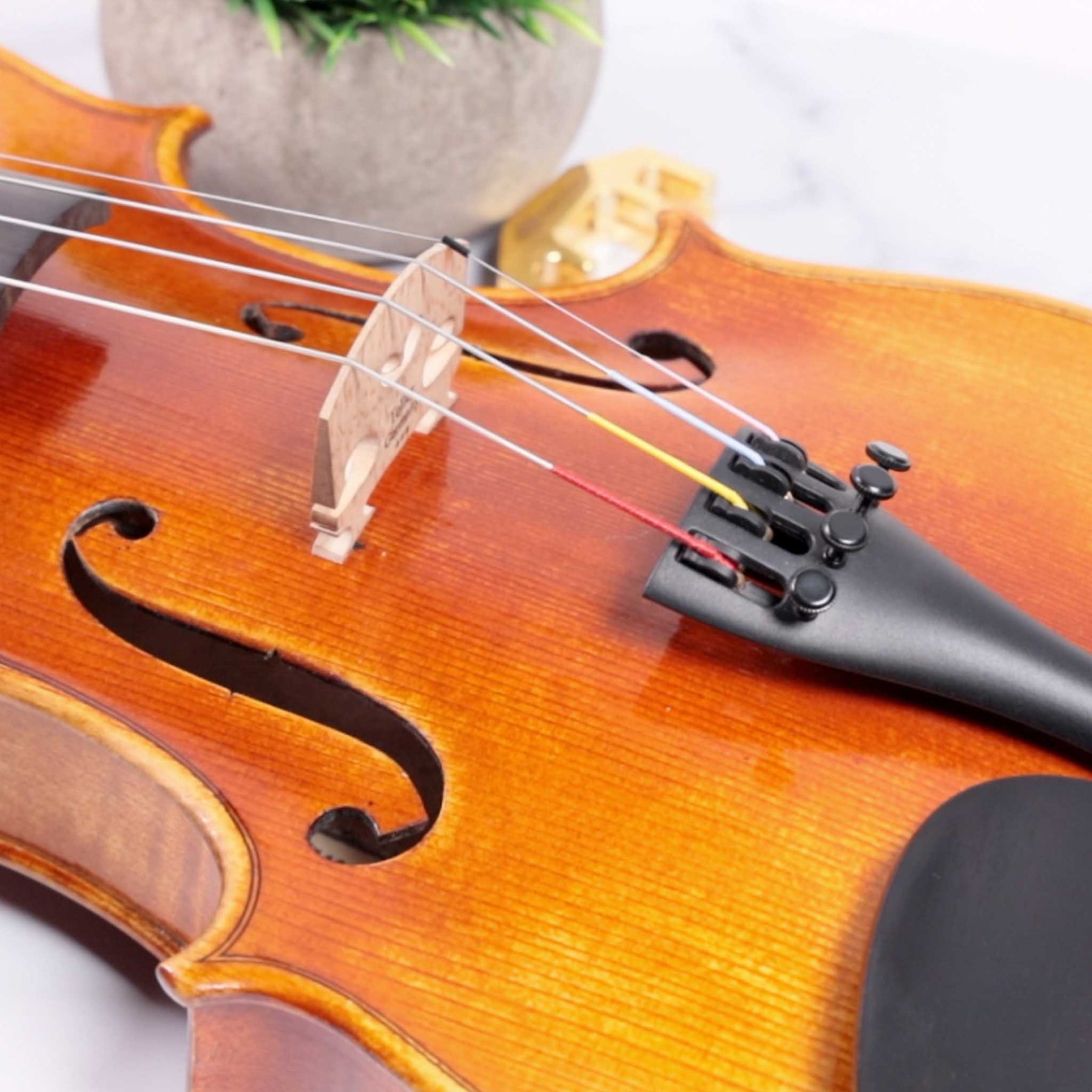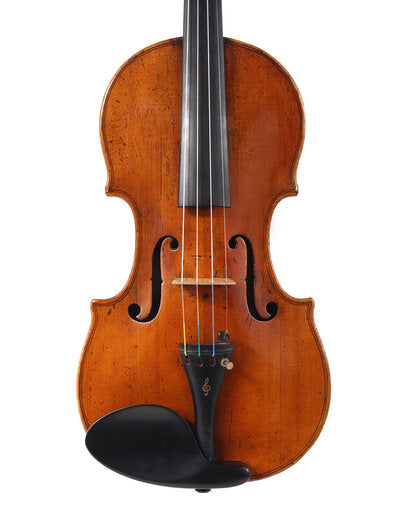Choosing Violin Strings: Synthetic Core vs. Steel vs. Gut String Comparison
Share
Violin strings are the direct interface between your musical expression and your instrument's voice. The choice between synthetic core, steel core, and gut strings fundamentally shapes your violin's tonal character, response, and playing experience. Each string type offers distinct advantages and characteristics that suit different playing styles, musical genres, and performance requirements. Understanding these differences empowers you to select strings that complement your instrument and enhance your musical goals.
The Foundation of String Performance

Before exploring specific string types, it's essential to understand how violin strings function within your instrument's acoustic system. Strings vibrate at specific frequencies, transferring energy through the bridge to the soundboard, where the violin's wooden body amplifies and projects the sound. The core material, winding technique, and manufacturing precision all influence how effectively this energy transfer occurs.
String performance depends on several key factors:
-
Core material composition and construction
-
Tension characteristics and stability
-
Harmonic content and overtone production
-
Response speed to bow articulation
-
Durability and tuning stability
-
Compatibility with your specific instrument
The interaction between strings and your violin's wood construction significantly affects the final sound. Premium strings can enhance an instrument's natural characteristics, while poor string choices may mask or distort your violin's inherent tonal qualities. Understanding how [different wood types affect tone and projection](Understanding Violin Wood: How Spruce and Maple Affect Tone and Projection) helps you appreciate why string selection must complement your instrument's acoustic properties.
Synthetic Core Strings: Modern Versatility and Warmth

Construction and Materials
Synthetic core strings represent the newest category in violin string technology, developed to combine the best characteristics of both gut and steel strings. These strings feature cores made from advanced synthetic materials such as:
-
Nylon-based compounds offering flexibility and warmth
-
Composite synthetic materials providing stability and response
-
Advanced polymer cores delivering consistent performance
-
Specialized winding materials including silver, aluminum, and chrome
Leading manufacturers like Thomastik-Infeld, D'Addario, and Pirastro have invested decades in synthetic core development, creating strings that offer gut-like warmth with steel-like stability.
Tonal Characteristics
Synthetic core strings typically produce:
-
Rich, complex harmonic content similar to gut strings
-
Warm, full-bodied tone across all registers
-
Excellent bow response with nuanced dynamic control
-
Balanced projection suitable for various musical styles
-
Consistent performance across different playing techniques
Popular synthetic core strings include:
-
Thomastik Dominant - The industry standard for warm, gut-like tone
-
D'Addario Zyex - Bright synthetic core with excellent projection
-
Pirastro Evah Pirazzi - Complex synthetic core with powerful response
-
Thomastik Vision - Modern synthetic offering clarity and power
Advantages of Synthetic Core Strings
Tuning Stability: Synthetic cores maintain pitch better than gut strings while offering more tonal complexity than steel cores.
Weather Resistance: Less affected by humidity and temperature changes compared to gut strings.
Longevity: Typically last longer than gut strings while maintaining consistent tone quality.
Versatility: Suitable for classical, chamber music, orchestral, and even some contemporary styles.
Response Quality: Quick bow response with excellent dynamic range capabilities.
Considerations and Limitations
Break-in Period: Most synthetic core strings require 1-2 weeks of playing to fully settle and develop their optimal tone.
Cost Factor: Generally more expensive than basic steel strings, though competitively priced with premium options.
String Life: While longer-lasting than gut, may not match the extreme longevity of some steel strings.
Steel Core Strings: Precision and Brilliance

Construction Characteristics
Steel core strings feature solid steel wire cores wound with various materials to modify tone and response. Construction variations include:
-
Solid steel cores providing maximum stability and projection
-
Stranded steel cores offering slightly more flexibility
-
Chrome steel windings for durability and brightness
-
Aluminum windings for warmth and responsiveness
-
Silver windings for complex harmonic content
Steel string manufacturing emphasizes precision and consistency, with tight quality control ensuring uniform performance across string sets.
Tonal Profile
Steel core strings characteristically offer:
-
Brilliant, clear projection ideal for cutting through ensemble textures
-
Immediate response to bow articulation
-
Consistent tone quality throughout the string's life
-
Excellent intonation stability
-
Direct, focused sound with clear fundamental frequencies
Popular steel core options include:
-
Thomastik Spirocore - Professional steel strings with complex tone
-
D'Addario Helicore - Versatile steel cores for various musical styles
-
Pirastro Chromcor - Student-friendly steel strings with good tone
-
Thomastik Alphayue - Entry-level steel strings with professional characteristics
Steel String Advantages
Immediate Playability: No break-in period required - optimal performance from installation.
Tuning Stability: Exceptional pitch stability, even with extreme temperature changes.
Durability: Longest lifespan of all string types, maintaining consistent performance.
Cost Effectiveness: Generally the most affordable option, especially for student applications.
Weather Resistance: Unaffected by humidity, temperature, or climate variations.
Steel String Limitations
Tonal Simplicity: May lack the harmonic complexity desired for advanced classical repertoire.
Reduced Warmth: Can sound harsh or metallic on some instruments without proper setup.
Limited Dynamic Range: May not offer the subtle dynamic control available with other string types.
Bow Response: Can feel less responsive to subtle bow technique variations.
Gut Strings: Traditional Warmth and Historical Authenticity

Traditional Construction
Gut strings represent the original violin string technology, crafted from sheep intestine processed into incredibly strong, flexible strands. Modern gut string production includes:
-
Plain gut cores for authentic historical sound
-
Wound gut cores with metal windings for enhanced projection
-
Varnished gut for improved durability and tuning stability
-
Modern gut processing techniques improving consistency
Premium gut string makers like Pirastro, Aquila, and Gamut maintain traditional crafting methods while incorporating modern quality control.
Distinctive Tonal Qualities
Gut strings provide:
-
Exceptionally rich harmonic content with complex overtones
-
Warm, singing tone quality prized in baroque and classical music
-
Incredible bow sensitivity responding to subtle technique variations
-
Natural compression that enhances musical phrasing
-
Organic sound character impossible to replicate with synthetic materials
Renowned gut string options include:
-
Pirastro Chorda - Traditional plain gut strings
-
Pirastro Eudoxa - Wound gut strings with modern convenience
-
Aquila Corde - High-quality Italian gut strings
-
Gamut - Premium American-made gut strings
Gut String Benefits
Unmatched Warmth: The gold standard for warm, complex violin tone.
Historical Authenticity: Essential for period performance and baroque music.
Expressive Response: Incredible sensitivity to bow pressure and speed variations.
Tonal Complexity: Rich harmonic content that enhances musical expression.
Natural Sound: Organic tone quality that complements violin's wooden resonance.
Gut String Challenges
Tuning Instability: Requires frequent tuning adjustments, especially during climate changes.
Climate Sensitivity: Performance significantly affected by humidity and temperature.
Limited Lifespan: Shorter string life compared to synthetic and steel alternatives.
Higher Maintenance: Requires more careful handling and storage.
Cost Factor: Generally the most expensive string option.
Setup Requirements: May need specific bridge and soundpost adjustments for optimal performance.
String Selection Based on Musical Style
Classical and Chamber Music
Classical repertoire often benefits from strings that provide:
-
Rich harmonic complexity for expressive interpretation
-
Subtle dynamic control for musical phrasing
-
Warmth that complements the violin's natural resonance
Recommended Options:
-
Synthetic core strings like Thomastik Dominant or Vision
-
Premium gut strings for historically informed performance
-
High-end steel strings like Spirocore for orchestral projection
Contemporary and Popular Music
Modern musical styles may prioritize:
-
Clear projection for amplified performance
-
Stable tuning for extended performances
-
Direct, focused tone for recording applications
Suitable Choices:
-
Steel core strings for reliability and projection
-
Bright synthetic cores like D'Addario Zyex
-
Hybrid sets combining different string types
Student and Educational Applications
Beginning and intermediate players typically need:
-
Stable tuning to focus on technique development
-
Durable construction for heavy practice use
-
Affordable replacement costs
-
Forgiving response characteristics
Practical Options:
-
Quality steel strings like Thomastik Alphayue
-
Student-grade synthetic cores like D'Addario Prelude
-
Durable steel cores like Pirastro Chromcor
The Role of Proper Setup in String Performance
String selection must consider your violin's setup characteristics. The interaction between bridge positioning, soundpost placement, and string type significantly affects final tone and playability. Even premium strings cannot overcome poor violin setup, while expert adjustment can maximize the potential of any string type.
Understanding how [bridge, soundpost, and string height optimization](Violin Setup and Adjustments: Bridge, Soundpost, and String Height Optimization) affects string performance helps you make informed decisions about both string selection and necessary setup modifications.
String Installation and Break-In Considerations
Proper Installation Techniques
Professional string installation ensures optimal performance:
-
Gradual tension increase prevents sudden stress on the instrument
-
Proper winding technique at the tuning pegs
-
Correct string spacing across the bridge and nut
-
Careful bridge positioning maintenance during installation
-
Final tuning stability checks before intensive playing
Break-In Periods by String Type
Different string types require varying break-in periods:
Steel Strings: Immediate optimal performance, minimal settling required.
Synthetic Core Strings: 1-2 weeks of regular playing for full tonal development.
Gut Strings: Extended break-in period with gradual tonal maturation over several weeks.
String Maintenance and Longevity
Maximizing String Life
Proper string care extends performance life:
-
Regular cleaning with appropriate string cleaners
-
Proper storage in stable climate conditions
-
Careful handling during tuning and playing
-
Rosin management to prevent excessive buildup
-
Professional maintenance including bridge and nut lubrication
Signs of String Replacement Need
Several indicators suggest string replacement:
-
Tonal degradation or loss of brilliance
-
Tuning instability or frequent pitch drift
-
Physical wear including fraying or false notes
-
Response deterioration or reduced bow sensitivity
-
Intonation problems particularly in higher positions
String Sets vs. Individual String Replacement
Complete Set Advantages
Replacing entire string sets ensures:
-
Consistent aging across all strings
-
Balanced tension and response characteristics
-
Optimal tonal balance between strings
-
Matching break-in periods
-
Uniform performance characteristics
Individual String Considerations
Single string replacement may be appropriate when:
-
Budget constraints require gradual replacement
-
Specific string failure occurs before others
-
Experimental combinations of different string types
-
Emergency repairs require immediate single string replacement
Advanced String Selection Strategies
Mixed String Sets
Experienced players sometimes combine different string types:
-
Steel E with synthetic A, D, G for projection and warmth balance
-
Gut G with synthetic upper strings for warmth without instability
-
Different brands within string types for specific tonal goals
Gauge Considerations
String gauge (thickness) affects:
-
Tension levels and playing feel
-
Tonal characteristics and projection
-
Bow response and articulation
-
Instrument stress and long-term health
String Selection for Different Instruments
Student Instruments
Budget violins often benefit from:
-
Steel strings that provide stable, clear tone
-
Forgiving response characteristics
-
Cost-effective replacement options
-
Durability for heavy practice use
Professional Instruments
High-quality violins can showcase:
-
Premium synthetic cores for complex tone
-
Gut strings for ultimate warmth and expression
-
Specialized string combinations for specific repertoire
-
Experimental options for unique tonal goals
Our collection of professional full-size violins includes instruments that demonstrate how proper string selection enhances each violin's individual characteristics. These instruments show how the right string choice can unlock an instrument's full potential.
The Economics of String Selection
Cost vs. Performance Analysis
String investment should consider:
-
Initial purchase cost vs. expected lifespan
-
Performance benefits for your playing level and goals
-
Replacement frequency and total annual string costs
-
Instrument compatibility and setup requirements
Professional Investment Perspective
For serious players, premium strings represent:
-
Enhanced practice efficiency through improved response
-
Performance confidence from reliable string behavior
-
Artistic expression capabilities from superior tonal options
-
Long-term value through extended instrument life and performance
Future Developments in String Technology
Modern string development continues advancing:
-
New synthetic materials offering improved performance characteristics
-
Advanced manufacturing techniques providing greater consistency
-
Hybrid construction methods combining different core materials
-
Specialized coatings extending string life and performance
The fundamental principles of string selection remain constant: matching string characteristics to your instrument, playing style, and musical goals creates the foundation for exceptional violin performance.
Choosing the right violin strings transforms your instrument's voice and your musical expression. Whether you select synthetic core strings for versatile warmth, steel strings for reliable brilliance, or gut strings for ultimate expressiveness, understanding each type's characteristics helps you make informed decisions that enhance your musical journey.

